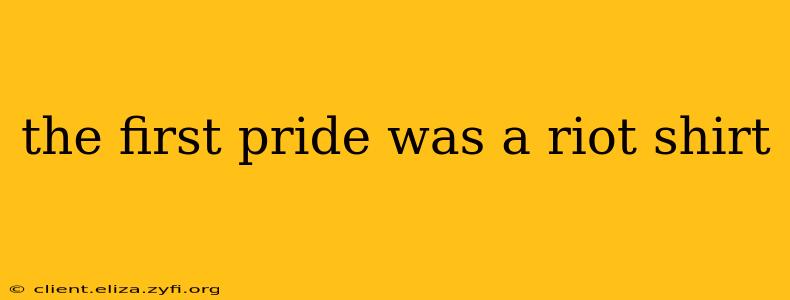The First Pride Was a Riot: Understanding the Legacy of Stonewall
The phrase "the first Pride was a riot" is more than a catchy slogan; it's a powerful statement reclaiming the radical roots of the LGBTQ+ rights movement. It serves as a crucial reminder of the struggles and sacrifices that paved the way for the Pride celebrations we see today. While modern Pride parades are often vibrant festivals of self-expression and community, understanding the events of the Stonewall Riots in 1969 is essential to grasping the full significance of Pride. This article will delve into the history of the Stonewall Riots, exploring their impact and addressing common questions surrounding this pivotal moment.
What Sparked the Stonewall Riots?
The Stonewall Inn, a gay bar in New York City's Greenwich Village, was a haven for marginalized LGBTQ+ individuals, particularly transgender women of color, who faced widespread discrimination and police harassment. Raids on gay bars were commonplace, but the raid on the Stonewall Inn in the early morning hours of June 28, 1969, proved to be a tipping point. The brutal and aggressive nature of the police action, coupled with the community's pent-up frustration and anger over years of oppression, ignited a spontaneous uprising. This wasn't a planned protest; it was a rebellion born out of years of systemic injustice.
Why is it important to remember that the first Pride was a riot?
Remembering that the first Pride was a riot is crucial for several reasons:
- Honoring the legacy of resistance: It acknowledges the courageous acts of those who fought back against oppression, often at great personal risk. Many participants in the Stonewall Riots were transgender women of color, whose contributions are often overlooked in mainstream narratives.
- Maintaining a radical perspective: It counters the tendency to sanitize the history of the LGBTQ+ rights movement and reminds us of the ongoing fight for equality and justice. Pride should not only be about celebration but also about continued activism.
- Understanding the roots of modern Pride: The riots were a catalyst for the formation of LGBTQ+ rights organizations and the annual Pride celebrations that follow. Understanding the context of the riots helps us appreciate the significance of Pride today.
What were the key events of the Stonewall Riots?
The Stonewall Riots weren't a single event but a series of clashes between police and LGBTQ+ people that spanned several nights. The initial police raid sparked immediate resistance, with patrons fighting back against arrest. The protests continued into the following nights, drawing increasing numbers of participants and escalating into violent confrontations. The riots showcased the power of collective action and the unwavering determination of a community fighting for its rights.
How did the Stonewall Riots impact the LGBTQ+ rights movement?
The Stonewall Riots served as a watershed moment, marking a turning point in the LGBTQ+ rights movement. The riots galvanized activism, leading to the formation of numerous organizations dedicated to advocating for LGBTQ+ rights and equality. It spurred greater visibility and helped pave the way for future advancements in LGBTQ+ rights, though the fight continues to this day.
What are some common misconceptions about the Stonewall Riots?
Several misconceptions surround the Stonewall Riots. One common misconception is that the riots were a solely gay, white, male event. In reality, transgender women of color played a pivotal, though often under-represented, role in instigating and sustaining the protests. Another misconception is that the riots were a single, organized event. Instead, they were spontaneous uprisings fueled by years of oppression and fueled by immediate reactions to police brutality. Accurate representation and remembering the contributions of marginalized communities are vital to honoring the true history of Stonewall.
How can we honor the legacy of Stonewall today?
We can honor the legacy of Stonewall by continuing the fight for LGBTQ+ rights and equality. This includes supporting LGBTQ+ organizations, advocating for inclusive policies, and challenging discrimination wherever we encounter it. Furthermore, we should actively learn about and amplify the voices of marginalized communities within the LGBTQ+ community, ensuring that their contributions are rightfully recognized and celebrated. True commemoration of Stonewall means actively working towards a more just and equitable world for all.
By understanding the history and significance of the Stonewall Riots, we can gain a deeper appreciation for the complexities and triumphs of the LGBTQ+ rights movement and the true meaning of Pride. It's a reminder that the vibrant celebrations we see today are built on a foundation of resistance, resilience, and the unwavering courage of those who fought for the rights we enjoy today.
